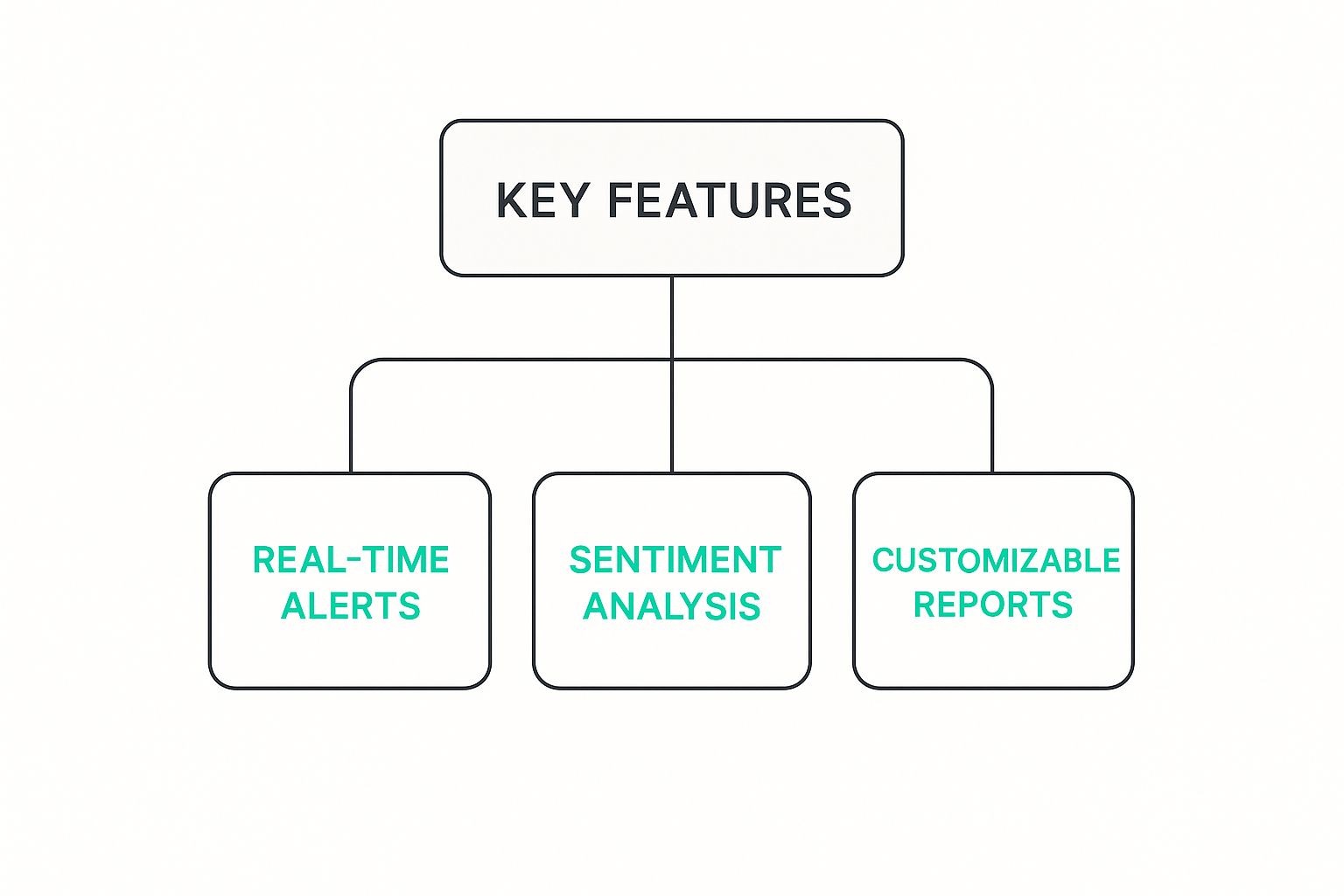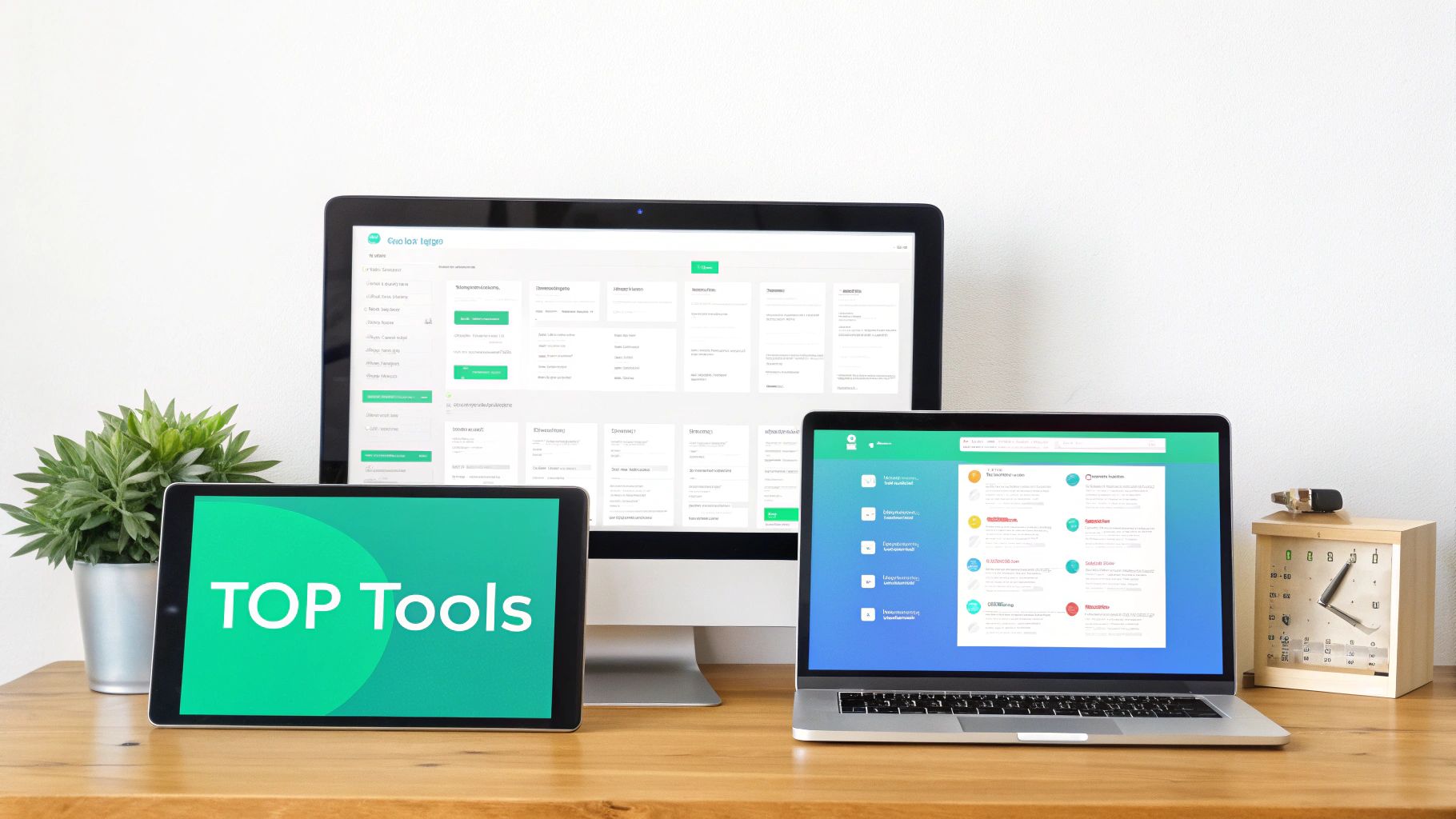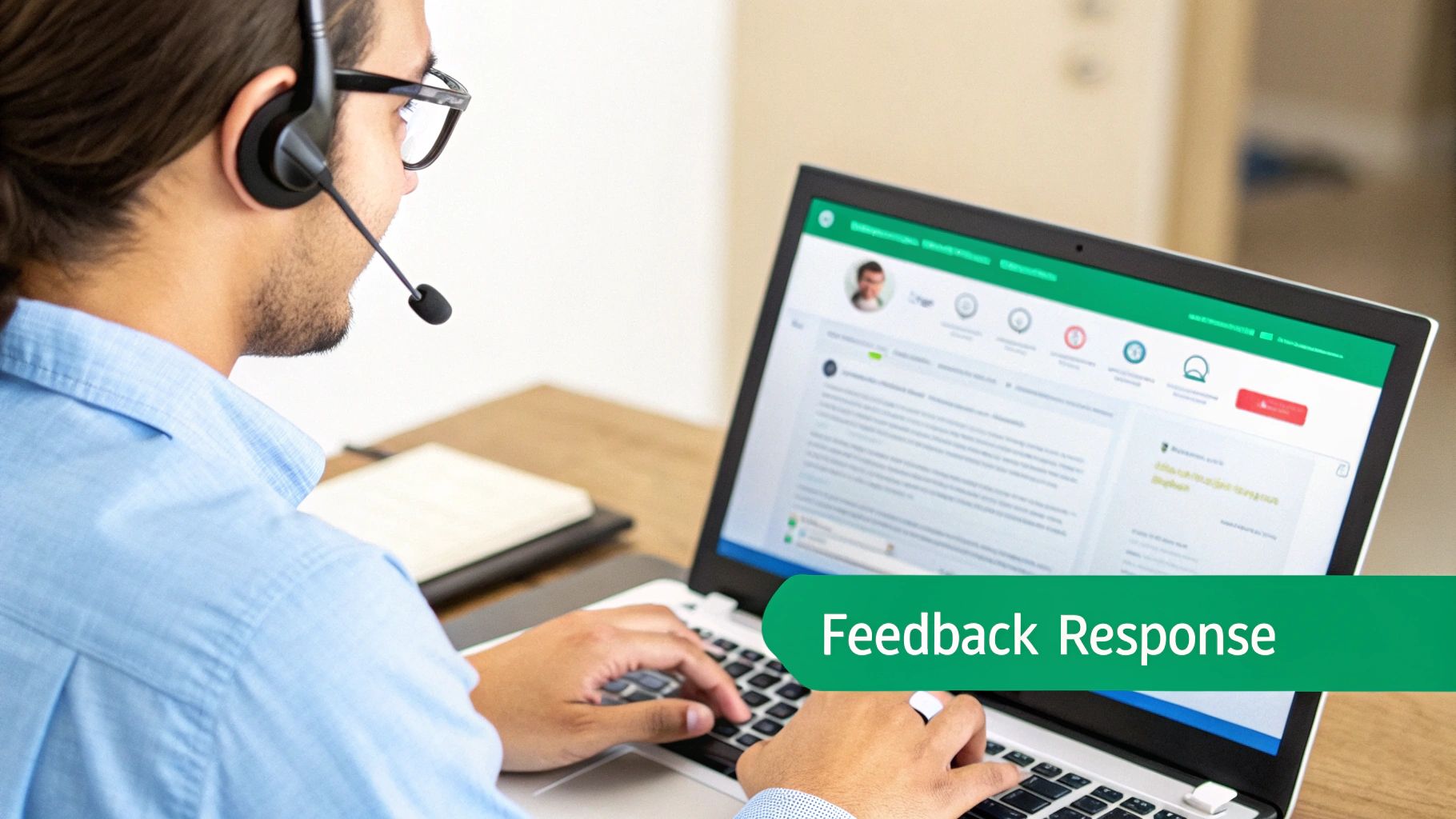A Guide to Online Reputation Monitoring Tools
Think of online reputation monitoring tools as your brand's personal radar system. These platforms are constantly scanning the digital world—social media, review sites, blogs, you name it—for any mention of your company. They act as your eyes and ears online, automating the massive job of listening in on conversations so you can protect your brand, chat with customers, and pick up on some incredibly useful business insights.
Your Digital Reputation Is Your Bottom Line
Right now, thousands of conversations about your brand could be happening online. Before a potential customer even thinks about calling your sales team or walking through your door, they’re doing their own homework. In fact, a recent study found that 85% of consumers trust online reviews just as much as a recommendation from a friend. That digital handshake is your first impression today, and it happens long before you’re even in the room.
Trying to manually keep up with every single review, social media tag, forum post, and news story is just not possible. The internet moves way too fast. A single negative comment can catch fire and shape how people see you before you even know it’s there. This is exactly where having a smart monitoring tool becomes a game-changer.
From Defense to Business Intelligence
It’s easy to think of reputation management as just playing defense, putting out fires as they pop up. But that’s a huge missed opportunity. A much better way to look at these tools is as a core part of your business intelligence. They’re like a command center for your brand's public image, turning all that chaotic online noise into clean, actionable data.
"A brand for a company is like a reputation for a person. You earn reputation by trying to do hard things well." - Jeff Bezos
Getting this shift in mindset right is everything. When you actively listen to what people are saying, you start to uncover priceless insights that can steer real, strategic growth.
Why Every Conversation Matters
Every single mention online is a piece of a larger puzzle, helping you get a real feel for customer sentiment and what’s happening in the market. With these tools, you can finally:
- Protect Brand Equity: Spot negative feedback or false information right away and step in before it snowballs into a crisis. This protects the trust you’ve worked so hard to build.
- Improve Customer Experience: See patterns in feedback to find weak spots in your operations, problems with a product, or gaps in your customer service that need fixing.
- Uncover Competitive Insights: Keep an eye on what people are saying about your competitors. You can learn about their strengths, weaknesses, and find gaps in the market you can fill.
- Drive Strategic Growth: Use what you learn from customers to guide everything from new product ideas to your next marketing campaign, making sure your decisions are plugged into what the market actually wants.
At the end of the day, investing in online reputation monitoring tools isn't just about managing bad reviews. It’s about investing in a deeper connection with your customers and your market. It gives you the data you need to handle challenges, build relationships that last, and lock in your spot as a leader people trust.
How Online Reputation Monitoring Tools Work

Think of online reputation monitoring tools as your brand's own team of digital detectives, working around the clock. These platforms aren't just sitting around waiting for news to break; they're actively scouring the entire internet, 24/7, for any mention of your brand.
At their heart, these tools are powered by sophisticated web crawlers—not unlike the "spiders" search engines like Google use to index the web. You start by feeding the tool a list of keywords to track, such as your company name, product names, key executives, or even specific branded hashtags.
From there, the crawlers go to work, digging through a massive range of online sources:
- Social Media Platforms like X (formerly Twitter), LinkedIn, and Reddit.
- Review Websites such as Google Reviews, Yelp, and other industry-specific sites.
- Forums and Discussion Boards where niche communities share their thoughts.
- Blogs and News Outlets, from major publications all the way down to independent writers.
This relentless crawling creates a digital dragnet, making sure you get a near-instant feed of every new conversation, review, or article that involves your brand.
Turning Noise into Actionable Signals
Just gathering a heap of mentions isn't very useful. The real power of these tools is how they process and analyze all that raw data to pull out what actually matters. This is where the magic really happens.
The most important function here is sentiment analysis. Using advanced AI—specifically natural language processing (NLP)—the tool reads each mention and figures out the emotion behind it. Is the comment positive, negative, or neutral?
This feature lets you instantly gauge how the public feels about you. Instead of manually slogging through thousands of comments, you get a clear, data-driven picture of customer sentiment. It helps you spot trends in customer happiness or frustration long before they blow up.
This analysis transforms a chaotic mess of online chatter into a structured, easy-to-read dashboard. You can filter mentions by sentiment, where they came from, or by date, which helps you prioritize what needs a response first. A sudden spike in negative comments from a specific review site, for instance, becomes an immediate red flag demanding your attention. For more on using AI to find customer signals, check out our guide on AI lead generation tools for a deeper look at similar technologies.
From Data Collection to Real-Time Alerts
The final piece of the puzzle is turning these insights into immediate action. The best online reputation monitoring tools have highly customizable alert systems. You can set up triggers for specific events to make sure the right information gets to the right person, right when they need it.
For instance, you could set up alerts for:
- Any review below 3 stars on a major platform, sent straight to your customer support manager.
- Mentions from high-authority news sites, delivered directly to your PR team’s inbox.
- A sudden spike in negative mentions on social media, triggering an urgent notification to your crisis management team.
This automated alert system is what connects monitoring with actual management. It gets rid of the need to constantly check everything by hand and empowers your team to be proactive instead of reactive. By flagging urgent issues the moment they pop up, these tools give you the critical time you need to craft a smart response, fix customer problems, and protect your brand's integrity.
This whole process—crawling, analyzing, and alerting—is what makes these platforms so essential for any modern business. The global online reputation management market was valued at $4.5 billion in 2023 and is expected to jump to $13.7 billion by 2032, which shows just how crucial this has become. You can find more insights on this fast-growing market over at DataIntelo.
What to Look for in a Top Monitoring Tool
Sifting through the endless list of online reputation monitoring tools can feel like a chore. But once you know what to look for, the best platforms quickly stand out from the pack. It's a bit like buying a new car—sure, most of them will get you from point A to point B, but the ones with the best navigation, safety alerts, and performance diagnostics deliver a completely different experience.
The best tools aren't just collecting data; they're your command center for brand health. There's a reason the market for this software is booming, with projections showing it will hit USD 11.6 billion by 2033 and growing at a steady 8.5% CAGR. This growth comes from the demand for truly powerful features that go beyond basic alerts. Want to dig deeper? You can read the full research about this market expansion to see where things are headed.
This diagram breaks down the core pillars of any great monitoring tool, starting from data collection and branching out into alerts, analysis, and reporting.

As you can see, it all starts with gathering information but quickly evolves into a proactive system for managing your brand's presence across the web. Let's look at the features that make this happen.
Key Features of Online Reputation Monitoring Tools
So, what are the non-negotiables? Below is a quick breakdown of the features that separate the basic tools from the ones that deliver real strategic value. Think of this as your checklist when comparing different platforms.
| Feature | What It Does | Why It's Important |
|---|---|---|
| Multi-Channel Monitoring | Scans social media, review sites, news, forums, and blogs for brand mentions. | Gives you a complete, 360-degree view of where conversations are happening, so nothing slips through the cracks. |
| AI-Powered Sentiment Analysis | Automatically analyzes the emotion (positive, negative, neutral) behind each mention. | Instantly gauges public perception, tracks the impact of campaigns, and spots potential crises before they escalate. |
| Review Aggregation | Pulls all your reviews from various platforms into a single, unified dashboard. | Saves countless hours and allows your team to respond to feedback quickly and spot recurring issues across all locations. |
| Competitive Benchmarking | Tracks your competitors' mentions, sentiment, and share of voice. | Turns monitoring into a competitive advantage by letting you spot their weaknesses and capitalize on opportunities. |
| Real-Time Alerts | Sends instant notifications for keywords, negative reviews, or spikes in mentions. | Allows for rapid response, which is critical for managing negative feedback and protecting your brand image. |
| Customizable Reporting | Generates detailed reports on key metrics, trends, and performance over time. | Provides the data needed to prove ROI, justify your strategy, and make informed decisions for the future. |
These features work together to create a powerful system. You're not just listening to conversations; you're understanding them, acting on them, and using the insights to get ahead.
Multi-Channel Social Listening and Web Monitoring
First things first: a great tool needs to cast a wide net. Conversations about your brand aren't happening in just one or two places. They're scattered across countless social networks, forums, and review sites.
An effective platform monitors all of it in real time, including:
- Major Social Networks like X (formerly Twitter), LinkedIn, Reddit, and Facebook.
- Review Aggregators such as Google Reviews, Yelp, G2, and Capterra.
- Forums and Blogs where niche communities and industry experts hang out.
- News Outlets and Press Mentions, from local newspapers to major publications.
This comprehensive coverage is everything. For a B2B software company, the most honest and valuable feedback might not come from a big review site, but from a deep-cut thread in a developer forum or a specialized subreddit. If you're not listening there, you're missing a huge piece of the puzzle.
AI-Powered Sentiment Analysis
Just collecting mentions isn't enough. You need to know what people feel. Are they happy? Frustrated? Indifferent? This is where AI-powered sentiment analysis comes in, and it's a total game-changer.
Instead of having someone on your team manually read through thousands of comments to get a feel for the mood, the software does it for you in seconds. It analyzes the text and flags each mention as positive, negative, or neutral.
This technology is what separates a simple alert system from a true business intelligence tool. It allows you to track shifts in public perception over time, measure the emotional impact of a marketing campaign, or quickly identify a surge in customer frustration before it escalates into a full-blown crisis.
Think about a national retailer launching a new product. By monitoring sentiment, they might notice a sudden spike in negative comments coming from one specific city. A quick investigation could reveal a local shipping delay or an issue with in-store displays, allowing them to jump on the problem and fix it right away.
Review Aggregation and Management
For most businesses today, online reviews are the ultimate form of social proof. A top-tier monitoring tool makes managing them ridiculously easy by pulling reviews from hundreds of sites into one central dashboard. This alone saves a massive amount of time.
But more importantly, it lets your team manage everything from one place. You can:
- Get instant alerts for new reviews, especially the negative ones that need immediate attention.
- Respond directly to customers on many platforms without having to log in and out of a dozen different accounts.
- Spot recurring themes in feedback, whether it's across different locations or product lines.
Imagine a restaurant chain seeing a pattern of complaints about "slow service" bubbling up across several locations. That aggregated data turns isolated incidents into clear evidence of a systemic training issue that needs to be addressed.
Competitive Benchmarking and Analysis
Knowing your own reputation is one thing. Seeing how it stacks up against your competition is a whole other level of strategic insight. The best online reputation monitoring tools let you track your competitors' mentions, sentiment, and share of voice just as easily as you track your own.
This unlocks some powerful opportunities. You can benchmark your performance against your closest rivals, pinpoint their weaknesses based on what their customers are saying, and even find chances to capitalize on their mistakes.
Let's say a SaaS company is tracking its main competitor. They suddenly notice a wave of negative sentiment after the competitor rolls out a confusing new pricing model. Their sales team can immediately use that intel to highlight their own simple, transparent pricing in conversations with prospects. Just like that, monitoring shifts from a defensive play to an offensive growth strategy.
The Strategic Benefits of Reputation Monitoring

It’s easy to think of online reputation monitoring tools as just a defensive shield, something you pull out when there’s a problem. But that’s a huge mistake. While they’re fantastic for crisis management, their real power comes from driving proactive, smart business growth. These platforms aren't just another operational cost; they're a strategic investment in business intelligence that pays for itself.
When you systematically listen to the unfiltered voice of your customers, you can stop just reacting to feedback. You start to anticipate what the market needs, fine-tune your products, and build a brand that people genuinely trust and want to tell their friends about. This is how you turn your reputation from something you simply protect into an asset you actively build.
The modern customer journey is completely shaped by digital word-of-mouth. Think about it: research shows 93% of buyers rely on online reviews to make purchasing decisions. And even more telling, 74% will walk away from a brand if they see negative content on the first page of Google. The stakes are high. You can discover more insights about these consumer dynamics from Verified Market Reports to see just how much this matters.
Build Unbreakable Customer Trust
Trust is the bedrock of any lasting business relationship, and today, that trust is built right out in the open. When potential customers see you actively engaging with feedback—thanking people for positive reviews and offering real solutions for negative ones—it sends a powerful signal. It says you care, you're listening, and you’re accountable.
This kind of consistent engagement does more than fix one-off problems. It creates a public track record of your company's dedication to customer satisfaction. That makes new prospects feel much more confident choosing you over a competitor who stays silent.
"Your brand isn’t what you say it is. It’s what Google says it is." - Chris Anderson, Curator of TED
This quote absolutely nails the reality of today's market. Your reputation is defined by the conversations happening about you online. Monitoring tools give you a seat at that table, letting you join in and shape the narrative in a real, authentic way.
Improve Local SEO and Visibility
For any business with a physical location, online reviews are a massive ranking factor for local search. Search engines like Google want to connect users with the best, most trusted local options. A steady flow of recent, positive reviews is one of the strongest signals you can send that your business is high-quality and relevant.
An online reputation monitoring tool becomes your secret weapon here. It helps you:
- Generate More Reviews: Many platforms have features to automate review requests, nudging happy customers to share their feedback at just the right moment.
- Boost Engagement Signals: By responding to reviews quickly, you show search engines that your business listing is active and managed, which can give your visibility a nice little bump.
- Improve Star Ratings: Over time, a consistent stream of new, positive feedback naturally lifts your overall rating, making your business pop in search results and on maps.
This creates a powerful, self-reinforcing cycle. Better reviews lead to higher rankings, which drives more traffic and new customers, who then leave—you guessed it—more reviews. Our complete guide on social media reputation monitoring offers even more strategies for using social proof to your advantage.
Uncover Invaluable Product and Operational Feedback
Your customers are a goldmine of business intelligence. They're giving you daily insights into your products, services, and operations—if you’re listening. An online reputation monitoring tool is the equipment you need to mine that gold. It pulls out valuable feedback that would otherwise get lost in the noise.
Imagine a restaurant chain starts seeing a recurring theme of "cold food" in reviews from one specific location. This isn't just a few random complaints; it's a clear operational signal. It points to a potential problem with equipment or staff training at that branch. Without a tool to pull all that data together, the pattern would be impossible to spot.
This feedback loop is incredibly powerful. It lets you:
- Identify Product Flaws: Spot trends in complaints about a specific feature or defect long before it turns into a costly recall or a messy public update.
- Pinpoint Service Gaps: Discover weaknesses in your customer service process, whether it's slow response times or unhelpful support agents.
- Validate New Ideas: Track the sentiment around a new product launch or feature to get real-time validation from the market.
When you treat every piece of online feedback as a data point, you turn your reputation management into a direct line to your R&D, operations, and marketing teams. This approach ensures your business evolves based on what your customers actually want, helping secure your place as a market leader for the long haul.
How to Choose the Right Monitoring Tool
With so many online reputation monitoring tools out there, picking the right one can feel like a huge task. The key is to think about it like choosing a vehicle for a trip. A local bakery just needs a nimble scooter to zip around and check neighborhood reviews, but a global company needs a private jet to keep an eye on international news and social media chatter.
The goal is to sidestep the flashy features you'll never actually use. Instead, start by getting crystal clear on what you need to achieve. You're looking for a tool that fits your business, budget, and future goals without making your daily work more complicated or draining your bank account.
Define Your Core Monitoring Needs
Before you even sit through a single demo, take a moment to map out your absolute "must-haves." This simple step acts as your compass, pointing you toward platforms that are a genuine fit and helping you quickly rule out the ones that aren't.
Start by asking a few basic questions:
- Where do our most important conversations happen? A local restaurant will live and die by Google Reviews and Yelp, while a B2B software company will be more focused on LinkedIn, G2, and niche industry forums.
- What's our business scale? Are you a single-location shop, or are you managing feedback across dozens—or even hundreds—of locations? You need a tool that can grow with you.
- Who will be using the tool? Is this for a dedicated social media manager, or does your entire customer support team need access? The interface has to be easy for its intended users to pick up.
Answering these questions first keeps you from falling for a tool that’s either too basic for what you need or way too complex and expensive for your team to ever use well.
Your ideal tool shouldn't force you to change how you work; it should make your existing processes better. The right platform will feel like a natural extension of your team, getting the right information to the right people at just the right time.
Evaluate Critical Selection Criteria
Once you have a clear picture of what you need, you can start sizing up potential online reputation monitoring tools against a few universal criteria. Think of this as your final inspection checklist before you sign on the dotted line.
You’re looking for a good balance of power, ease of use, and support. A tool can have all the features in the world, but if your team can't figure it out or can't get help when they're stuck, it's a wasted investment. A solid choice often comes down to how well the platform fits into your daily operations. This is especially true for businesses focused on bringing in new customers. You can check out a beginner's guide to B2B lead generation to see how reputation monitoring can feed directly into your sales efforts.
Key Evaluation Points
When you're watching demos, keep these four areas in mind. They reflect the practical, day-to-day reality of using the software and are often the difference between a tool that helps and one that just creates headaches.
Scalability and Growth Potential Your business is going to grow, and your tool needs to grow with it. Can you easily add more users, monitor more locations, or track more keywords without the price suddenly skyrocketing? A platform that works for you today should still work for you in two years.
Integration Capabilities A great tool plays well with others. Check if it integrates with the software you already use, like your CRM (think Salesforce), help desk software (like Zendesk), or team communication apps (like Slack). Smooth integrations create efficient workflows and stop your monitoring tool from becoming just another isolated island of data.
User-Friendliness and Team Adoption The interface should be clean, intuitive, and easy to find your way around. If your team needs weeks of training just to understand the main dashboard, they’re probably not going to use it consistently. The easier it is to use, the better the return on your investment.
Transparent and Fair Pricing Look for clear, straightforward pricing models. Stay away from platforms with hidden fees or long, confusing contracts. A good provider will offer flexible plans that make sense for your usage, whether it's based on the number of mentions, users, or locations you're tracking.
Putting Your Tool to Work for Maximum Impact

A powerful tool is only half the battle. The real magic happens when you weave it into the daily rhythm of your business. Just switching on an online reputation monitoring tool is like getting a smoke detector but forgetting the batteries. To actually see a difference, you need a smart plan that turns all that raw data into real business improvements.
This means moving from just listening in to actively engaging. The goal is to build a solid framework where every piece of feedback—good, bad, or ugly—kicks off a specific, productive action inside your company.
Set Up Smart, Actionable Alerts
First things first, you have to tame the firehose of information. If every single mention pings your team, they'll burn out on notifications in a day. Important stuff gets lost in the noise. The trick is to create filtered alerts that deliver only the critical info.
Focus on setting up notifications for specific, high-stakes events:
- Urgent Negative Feedback: Create an alert for any review that drops below a certain score (like 2 stars) to ping your customer support lead immediately.
- High-Profile Mentions: Set up notifications for when major news outlets or verified social media accounts mention you. This lets your PR and marketing teams jump on it.
- Sudden Spikes in Volume: Configure an alert for a sudden jump in mentions. This could be the first sign of a brewing crisis or a marketing campaign that’s gone viral.
This targeted approach gets the right information to the right people, right away, so they can organize a fast response. Your alert system transforms from a constant distraction into a focused, strategic asset.
It's no surprise that cloud-based tools hold a dominant 73.35% market share, thanks to their scalability and AI features that make real-time alerts possible. Still, many smaller businesses aren't fully aware of these perks. You can learn more about ORM market trends to see how cloud solutions are leading the way.
Create a Clear Response Playbook
Once the alerts are firing, your team needs to know exactly what to do next. A clear response protocol kills confusion and makes sure every customer interaction is handled the same way, every time. You need to define who owns what.
Your response protocol should be a simple playbook that outlines how to handle different scenarios. This ensures every mention is addressed and no customer feels ignored.
For example, your playbook might assign a customer support specialist to respond to all negative reviews within 24 hours, while a community manager handles the positive shout-outs on social media. This division of labor ensures every conversation is managed by the person best suited for the job.
Most importantly, you have to close the loop. The insights you gather from these customer conversations are gold. They're too valuable to get stuck in a support ticket silo. Funnel this data directly to your product, marketing, and operations teams. This is how customer feedback becomes a powerful driver for real, data-backed improvements across the entire business.
Got Questions? We've Got Answers
Jumping into online reputation monitoring can bring up a few questions. That's perfectly normal. Getting the answers sorted out is the best way to move forward with a clear, effective plan. Here are a few of the most common things we hear from businesses just like yours.
How Quickly Will I See Results?
You’ll start seeing data almost immediately. As soon as you set up your tool and plug in your keywords, it begins pulling in mentions from across the web. This gives you a live look at the conversation right from day one.
As for actual improvements, you can often see operational wins—like responding to customer reviews faster—within the first few weeks. But the bigger, more strategic results, like a real shift in brand sentiment or a boost in local search rankings from getting more reviews, usually take about 3-6 months of consistent work to really show.
Can These Tools Actually Remove Negative Reviews?
In short, no. These tools can't just go in and delete a legitimate review from a site like Google or Yelp. Their main job is to flag feedback for you so you can jump on it with a thoughtful, professional response.
The best move is always to address the customer's issue right there in a public reply. It shows the original poster you're listening, and it proves to everyone else reading that you take accountability.
Where the software does help is in spotting and flagging reviews that break a platform's rules—think spam, hate speech, or clearly fake content. In those situations, the tool helps you gather the evidence you need to report the review and ask the platform to take it down.
Are Reputation Tools Just for Big Companies?
Not at all. While they're definitely a must-have for huge companies swimming in online mentions, you could argue they're even more important for small and medium-sized businesses (SMBs). For a smaller brand, just one string of bad reviews or a single negative post that goes viral can do some serious damage to its credibility.
Most modern online reputation monitoring tools get this, which is why they offer flexible pricing plans built for SMBs. These plans give you access to all the core features you need, like review monitoring and social listening, without the hefty enterprise price tag. It makes powerful reputation management something any business can actually do.
Ready to stop guessing what customers are saying and start listening? Intently uses AI to monitor high-intent conversations on social platforms, delivering qualified leads and critical brand insights directly to you. Discover how Intently can transform your social listening strategy today.
